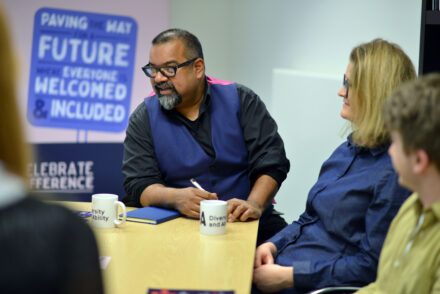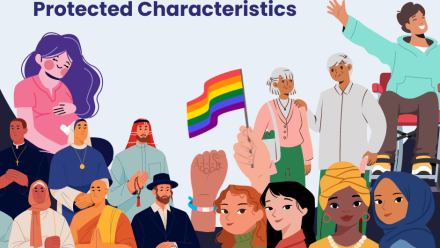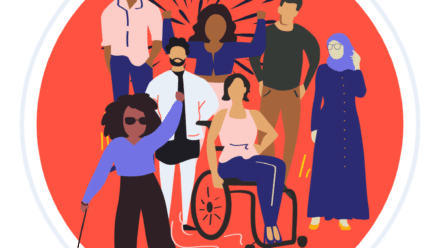Why diversity and inclusion is vital for your employee retention
27th January 2021 by Ellie Thompson
Employee retention is central to the success of a business: high turnover costs time and money, impacts morale of all employees, and marrs an organisation’s reputation.
We know that employers are aware of this, and it’s a key priority to reduce the number of employees leaving their roles. But you’ll find that your employee retention strategy falls short unless you take a truly inclusive approach. Organisations who lead in diversity and inclusion also report higher rates of employee retention. So why not reap the many rewards of a diverse and inclusive workplace?
“Diversity is a business strategy that needs to be built into every decision”- Emma Turner, Partnerships and Outreach Lead, Diversity and Ability

Fostering a sense of belonging
Exit interviews with employees show that a major factor in leaving a job is lacking a sense of belonging. The key to really making sure your employees feel safe and comfortable in their work environment is to not stop at diversity. Promote real, authentic inclusion, too. As our CEO Atif says, “Diversity is about counting people, inclusion is about insisting they count”.
To do this, you need to look beyond hiring quotas and legal requirements to make sure you have staff who feel truly able to bring their whole selves to work and know that they are valued for doing so.
We know that organisations are slowly but surely becoming more diverse. But more needs to be done to be truly inclusive, and so far as a society we are falling far short. For disabled employees, research shows that 77% of employees and 80% of leaders who are disabled chose not to share their disability in their workplace. For LGBTQ workers, 46% are closeted at their place of work. And across all diverse characteristics, 75% of employees feel the need to mask their differences or downplay them during work.
The impact of having to mask or hide aspects of yourself during the work day cannot be underestimated. It affects job performance, confidence and contributions, but also motivation, desire to progress and even feelings of safety. Of course, all of this in turn leads to employees who feel no real loyalty to their company.
If that alone isn’t enough to motivate you to prioritise diversity and inclusion, maybe it helps to know that doing so doesn’t just impact your minority employees. Research has shown that a lack of diversity and high staff turnover amongst minorities impacts all employees, even those who aren’t directly affected. Employees witness the disparity and discrimination against others and naturally feel less connected to their company themselves. So inclusion really is a win-win approach!
Diverse organisations celebrate difference and promote individual self-esteem
Why is it that diverse and inclusive organisations are so much more successful than their non-diverse counterparts?
Of course, there are lots of reasons that diversity and inclusion equals success for your business, but one important factor is the concrete business value of celebrating difference and encouraging diversity of thought and experience.
A business that’s inclusive is a business that gives space and a voice to all employees. It allows them to come as they are, rather than lauding the ideal of one perfect worker. As well as creating space for innovation, the inclusive approach also ensures employees feel recognised and valued for who they are.
You’re probably aware that the most common reason for employees to leave their role is lack of recognition and appreciation. You may have even implemented an employee recognition program with prizes, awards, or public celebration. The best way to really make your employees feel recognised is simple: genuinely encourage and celebrate diversity and individuality!

Top down diversity shows your employees they can progress
At the end of the day, your employees will only really stay at your organisation long-term if they see a future for themselves. That’s why it’s so important for your organisation to be truly diverse at every level.
In the most recent ethnicity pay gap report we can see that diversity statistics are improving and the ethnicity pay gap is the lowest it’s been since 2012. But few employees in entry-level, lower-paid roles are progressing to leadership levels.
For example, just 1.5% of top management roles in the UK are held by Black people, and only 7% of board-level executives identified as disabled (out of the 18.6% of the working population who are disabled).
If you only see your peers at your level, what evidence do you have that it is even possible for you to progress? Or that your organisation would support you to do so?
How would it feel to see a leadership team that’s truly diverse? If you see signs that your employer is committed to true inclusivity, you see potential to progress and are more likely to stay with your organisation for the long-term.
Diversity and inclusion means creating a work environment that’s comfortable and accessible for all
Employees who feel truly comfortable, both physically and mentally, at work are more likely to feel loyal to their employers, and reward them with higher employee retention.
This usual advice on comfortable working environments certainly applies. Of course, an adequate temperature, and well-lit spaces make a world of difference to employees. But to be a true diversity and inclusion leader, you need to recognise that comfort means something different to everyone, especially when it comes to disability.
For employees with chronic pain conditions, a comfortable space may be one where they can frequently adapt their working position to manage pain spikes. For autistic employees, the most comfortable space will likely be one with no background noise or chatter. And for employees with mental health conditions, comfort may mean a separate break-out space for when they need a breather.
Comfort is different for everyone, and it would be impossible to create the ultimate comfortable workspace for all your employees. But you can be proactive and anticipate these differences by simply asking your employees: “what does a comfortable workspace look like for you?”.This means you’ll be able to do your best to make the space accessible, boost job satisfaction, and keep staff turnover low.

One vital factor for an inclusive workplace is flexible working. Perhaps a key lesson of COVID-19 is that flexible working, with remote work and the ability to choose your own hours, benefits everyone. Allowing employees the flexibility to work however fits them best has been shown to improve employee engagement and satisfaction.
But there’s a particular case for flexible working when it comes to diversity and inclusion. Groups who face discrimination and disadvantage (disabled people, women and/or People of Colour for example) are more likely to have demands outside of work. Giving people the ability to work in the way that works best for them means allowing your employees to fit work around access needs, caring responsibilities or family duties. So, flexible working means more accessible work and happier employees!
How to ensure you are a diverse and inclusive employer
To impact your staff retention through prioritising diversity and inclusion, you can:
- Implement diversity and inclusion training at all levels of the organisation, to increase awareness on diversity issues and prioritise inclusive practices. We offer a programme of disabled-led training and support opportunities to help you make the changes that matter. Find out which workshop is right for you.
- Start with inclusion from the get-go by making sure your employment practices are inclusive. As Adam Hyland, Director of Accessibility and Inclusion at D&A says, “employers should be shouting from the rooftops about their desire to recruit diverse candidates”.
- Support your employers. Whether it’s supporting disabled employees to apply for an Access to Work grant, or offering 1:1 support with mental health, Assistive Technology training, or skills and strategy coaching, find out the different services that could enable your employees to overcome the challenges they face.


